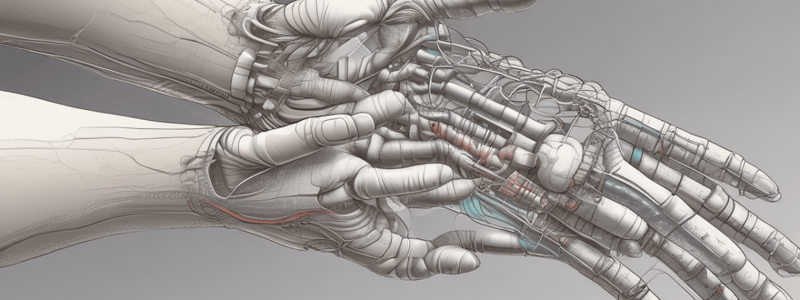Podcast
Questions and Answers
Which nerve is primarily affected in carpal tunnel syndrome?
Which nerve is primarily affected in carpal tunnel syndrome?
- Median nerve (correct)
- Ulnar nerve
- Musculocutaneous nerve
- Radial nerve
Which gender is more commonly affected by carpal tunnel syndrome?
Which gender is more commonly affected by carpal tunnel syndrome?
- Both males and females equally
- Males
- Females (correct)
- No gender predilection
What structures comprise the carpal tunnel?
What structures comprise the carpal tunnel?
- Ligaments of the wrist
- Flexor retinaculum and carpal bones (correct)
- Extensor tendons
- Radial artery
What could happen if there is increased pressure within the carpal tunnel?
What could happen if there is increased pressure within the carpal tunnel?
How many tendons are typically present within the carpal tunnel?
How many tendons are typically present within the carpal tunnel?
Aside from the median nerve, what else resides within the carpal tunnel?
Aside from the median nerve, what else resides within the carpal tunnel?
What are evidence-informed biological risk factors associated with the development of carpal tunnel syndrome?
What are evidence-informed biological risk factors associated with the development of carpal tunnel syndrome?
Which of the following is a clinical characteristic of carpal tunnel syndrome?
Which of the following is a clinical characteristic of carpal tunnel syndrome?
What deformity is associated with complete paralysis of thenar muscles in carpal tunnel syndrome?
What deformity is associated with complete paralysis of thenar muscles in carpal tunnel syndrome?
What symptom is experienced in carpal tunnel syndrome that worsens at night?
What symptom is experienced in carpal tunnel syndrome that worsens at night?
Which management approach is suggested for median nerve entrapments?
Which management approach is suggested for median nerve entrapments?
What type of splint is recommended to reduce nerve compression in carpal tunnel syndrome?
What type of splint is recommended to reduce nerve compression in carpal tunnel syndrome?
Which group of individuals should be referred for consideration of surgical intervention in carpal tunnel syndrome?
Which group of individuals should be referred for consideration of surgical intervention in carpal tunnel syndrome?
What can nonsteroidal anti-inflammatory drugs be used for in carpal tunnel syndrome?
What can nonsteroidal anti-inflammatory drugs be used for in carpal tunnel syndrome?
'Median claw hand deformity' in carpal tunnel syndrome results from paralysis of which muscle?
'Median claw hand deformity' in carpal tunnel syndrome results from paralysis of which muscle?
'Graded muscle stretching' is recommended for what purpose in carpal tunnel syndrome?
'Graded muscle stretching' is recommended for what purpose in carpal tunnel syndrome?
Flashcards are hidden until you start studying
Study Notes
Carpal Tunnel Syndrome Overview
- The median nerve is primarily affected in carpal tunnel syndrome.
- Females are more commonly affected than males in carpal tunnel syndrome cases.
Carpal Tunnel Anatomy
- The carpal tunnel comprises the carpal bones and the transverse carpal ligament.
- Typically, there are nine flexor tendons present within the carpal tunnel.
- In addition to the median nerve, the carpal tunnel houses flexor tendons and the synovial sheaths surrounding them.
Consequences of Increased Pressure
- Increased pressure within the carpal tunnel can lead to nerve compression, causing pain, numbness, and weakness in the hand.
Risk Factors
- Evidence-informed biological risk factors associated with carpal tunnel syndrome include repetitive wrist movements, obesity, diabetes, and hormonal changes.
Clinical Characteristics
- A clinical characteristic of carpal tunnel syndrome includes pain and tingling in the thumb, index, and middle fingers.
- "Median claw hand deformity" occurs due to complete paralysis of the thenar muscles.
Symptoms and Management
- Symptoms worsen at night, often leading to disturbed sleep patterns.
- Suggested management for median nerve entrapments includes activity modification and physical therapy.
Splinting and Surgical Intervention
- A wrist splint is recommended to reduce nerve compression in carpal tunnel syndrome.
- Individuals with severe symptoms or persistent impairment despite conservative measures should be referred for surgical intervention.
Pharmacological Treatment
- Nonsteroidal anti-inflammatory drugs (NSAIDs) can be used to relieve pain and inflammation in carpal tunnel syndrome.
Rehabilitation Strategies
- 'Graded muscle stretching' is recommended to improve flexibility and reduce symptoms in carpal tunnel syndrome.
Studying That Suits You
Use AI to generate personalized quizzes and flashcards to suit your learning preferences.




